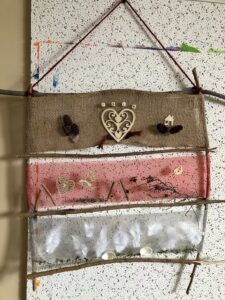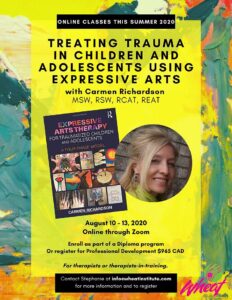
Treating Trauma using Expressive Arts
Carmen Richardson
MSW, RSW, RCAT, REAT
Carmen is a Registered Clinical Social Worker, Registered Expressive Arts Therapist and Registered Canadian Art Therapist in private practice. She is the founder and director of the Prairie Institute of Expressive Arts Therapy (PIEAT).

The dedication in my book, “Expressive Arts Therapy for Traumatized Children and Adolescents” reads, “To each child who taught me what it means to do brave therapy.” The learning with the young people I have journeyed with over the last 25 years culminated in the writing of this book. What stands out for me to this day, is the courage and the bravery it took from each child and teen to enter into the realm of healing the trauma wounds. I believe it is the medicine of the expressive arts that provides young people with the tools to cope, to ease the suffering, to make sense of and live with their transformed stories. I look so forward to sharing their stories of bravery this summer with those who attend my course in August!

“Transformed Story” by 16 year old girl. With permission.
The body. The expressive arts. Inseparable. Whether working with children, teens or adults, tapping into the body’s knowing is key. Having an understanding of the impact of trauma on the autonomic nervous system (ANS) invites an important element of healing to be understood, felt, and transformed. There is no better way to understand the ANS concepts, such as ventral vagal, dorsal vagal and sympathetic than by embodying the nervous system’s trauma response with the expressive arts. This learning will also be experienced through some of the teaching this August.

Creating/embodying our ANS states response to trauma (above and below images are from Advanced Trauma training at Prairie Institute of Expressive Arts Therapy, February 2020)


